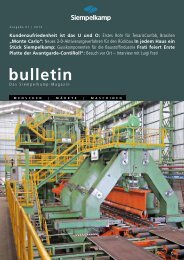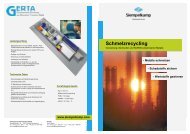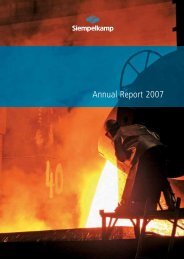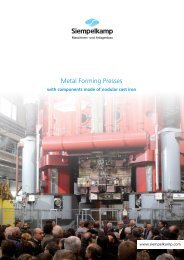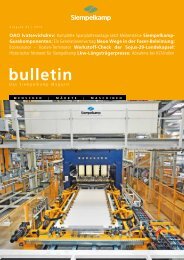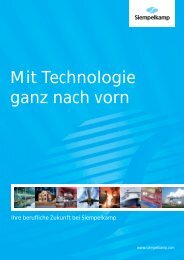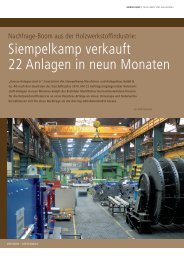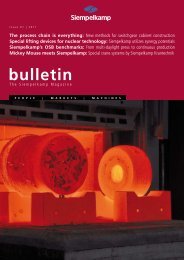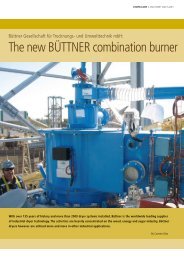Bulletin 2/2010 - Siempelkamp NIS
Bulletin 2/2010 - Siempelkamp NIS
Bulletin 2/2010 - Siempelkamp NIS
You also want an ePaper? Increase the reach of your titles
YUMPU automatically turns print PDFs into web optimized ePapers that Google loves.
Metals – a mini lesson in material science<br />
Gold – the name originates from the Indo-Germanic<br />
language and translates into “shiny yellow”. In the<br />
periodic table of the elements it has the symbol Au from<br />
the Latin term aurum, “shining dawn”.<br />
Copper – In the periodic table copper is identifi ed with<br />
the symbol Cu. It is derived from the Latin term cuprum,<br />
ore from the island of Cyprus, the stronghold of copper<br />
mining in antiquity.<br />
Platinum – In the periodic table it holds the symbol Pt.<br />
It is derived from the Spanish word platina. The metal is<br />
extremely corrosion-resistant and was used for the fi rst<br />
time in Egypt in 3000 before Christ.<br />
Nickel – In the periodic table this metal has the symbol<br />
Ni. In its elemental form it could only be detected in 24<br />
locations worldwide to date.<br />
Iron – In the periodic table iron has the symbol Fe which<br />
is derived from the Latin term ferrum. Verifi ably iron<br />
was used for the fi rst time around 4000 before Christ for<br />
making spearheads.<br />
SIEMPELKAMP | FOUNDRY<br />
Entrance to the gold-mine “The Super Pit” in Australia Mining excavator for rock mining<br />
Metal mining: gigantic projects with a fi nal touch<br />
Today metal-containing rocks are mined in large above-ground<br />
mines. As a matter of principle, extensive bank-approved<br />
feasibility and profi tability studies are completed in the forefront<br />
of these operations. After the funding is approved, the planning<br />
phase starts by determining which milling system best fi ts the<br />
geological structure. Gigantic project sizes with outputs of more<br />
than 250,000 t (275,578 US tons) of rock per day are very<br />
common today. The yield of a gold mine is sometimes only 1.2 g<br />
of pure gold per ton of rock. At a current gold price of<br />
approximately 1,200 USD per ounce, even the mining of such<br />
small amounts is considered economical. The most productive<br />
mining areas for copper are Chile, Peru and Australia, for gold<br />
and platinum the African continent and for nickel Russia and<br />
Canada. Mining equipment is even supplied to places such as<br />
Papua New Guinea and Burkina Faso.<br />
At the actual mining sites, gigantic diggers with single shovel<br />
volumes of up to 80 m³ are used. Dump trucks or heavy load<br />
vehicles with cargo weights of up to 400 t transport the mined<br />
material to crushing units.<br />
For the last 20 to 25 years, crushers, autogenous mills and semiautogenous<br />
mills as well as ball mills have been used to crush<br />
different types of material. These mill types with rotating<br />
cylinders that are mounted horizontally are used for the coarse<br />
grinding and the subsequent fi ne grinding of the respective<br />
mined rocks.





